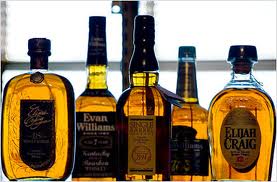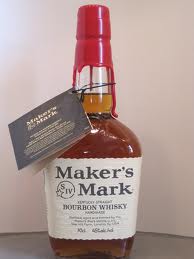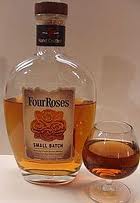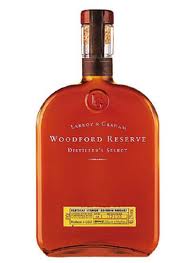A little taste of bourbon history a la Judge Boyce Martin and Maker’s Mark Distiller v. Diageo N. Am., 5/9/2012.
I thought this might be an appropriate legal discussion on the eve of Judge Martin’s retirement, and although Judge Martin was able to hide his bourbon preference, I am more than happy to share mine. For years, I enjoyed the taste of Woodford Reserve, but a few years back my neighbor Jack Rutledge enlightened me of the finer qualities of Jim Beam’s Four Roses and his brother Jim Rutledge who was their master distiller. Yes, I have seen the light, and soft golden light looking through the pane of Four Roses. Good stuff, and I do enjoy a taste with Coke ™ and ice just to push Jack a bit over the edge.
And now for a judicial opinion on the taste that made Kentucky famous:
BOYCE F. MARTIN, JR., Circuit Judge. Justice Hugo Black once wrote, “I was brought up to believe that Scotch whisky would need a tax preference to survive in competition with Kentucky bourbon.” Dep’t of Revenue v. James B. Beam Distilling Co. , 377 U.S. 341, 348-49 (1964) (Black, J., dissenting). While there may be some truth to Justice Black’s statement that paints Kentucky bourbon as such an economic force that its competitors need government protection or preference to compete with it, it does not mean a Kentucky bourbon distiller may not also avail itself of our laws to protect its assets. This brings us to the question before us today: whether the bourbon producer Maker’s Mark Distillery, Inc.’s registered trademark consisting of its signature trade dress element—a red dripping wax seal—is due protection, in the form of an injunction, from a similar trade dress element on Casa Cuervo, S.A. de C.V.’s Reserva de la Familia tequila bottles. We hold that it is. The judgments of the district court in this trademark infringement case are AFFIRMED .
I.
All bourbon is whiskey, but not all whiskey is bourbon.1 Whiskey, like other distilled spirits, begins as a fermentable mash, composed of water and grains or other fermentable ingredients. The mash is heated and then cooled, yeast is introduced to ferment the sugars in the mash, and the yeast turns the sugars into alcohol and carbon dioxide. This now-alcoholic liquid is then distilled to concentrate the alcohol. Gary Regan & Mardee Haidin Regan, The Bourbon Companion 32-33 (1998). The composition of the mash, and the aging, treating, and flavoring of the distilled alcohol, determine the flavor, color, and character of the distilled spirit. In the case of bourbon, the corn-based mash [415] and aging in charred new oak barrels impart a distinct mellow flavor and caramel color. Distillers compete intensely on flavor, but also through branding and marketing; the history of bourbon, in particular, illustrates why strong branding and differentiation is important in the distilled spirits market.
The legend of the birth of bourbon is not without controversy: “As many counties of Kentucky claim the first production of Bourbon as Greek cities quarrel over the birthplace of Homer.” H.F. Willkie, Beverage Spirits in America—A Brief History 19 (3d ed. 1949). The generally accepted and oft-repeated story is that “the first Bourbon whiskey . . . made from a mash containing at least fifty percent corn, is usually credited to a Baptist minister, The Reverend Elijah Craig, in 1789, at Georgetown, [Kentucky],” just prior to Kentucky’s joining the Union as a state in 1792. Id. But it is more likely that Kentucky whiskey was first distilled at Fort Harrod, the first permanent European settlement in what is now Kentucky, in 1774. Charles K. Cowdery, Bourbon, Straight: The Uncut and Unfiltered Story of American Whiskey 3-4 (2004); accord Willkie, supra, at 19. Kentucky’s settlers distilled whiskey using methods similar to those “used in Scotland and Ireland for hundreds of years,” Willkie, supra, at 20, except that Kentucky whiskey was made mostly from corn, a crop unknown to Europeans before Columbus ventured to America. Cowdery, Bourbon, Straight, supra, at 2. Though “most [American] colonial whiskey was made from rye,” id. at 3, corn was easy to grow in Kentuckysoil, and surplus corn was often used to make whiskey. Id. at 4.
The name “bourbon” itself is easier to trace: one of the original nine counties of Kentucky was Bourbon County, Willkie, supra, at 20, named in honor of the French royal family. Charles K. Cowdery, How Bourbon Whiskey Really Got Its Famous Name, Bourbon Country Reader, July 1996. “[Kentucky] whiskey was shipped from Limestone, a riverside port in Bourbon County,” down the Ohio river to the Mississippi, bound for New Orleans. Regan & Regan, supra, at 14. Whiskey shipped from the port in Bourbon County came to be known as “Old Bourbon,” and later, simply “Bourbon,” to distinguish it from Pennsylvania Rye or other whiskeys. Cowdery, How Bourbon Whiskey Really Got Its Famous Name, supra. The name “bourbon” at that time meant whiskey made from mostly corn in Kentucky or points west. But it was likely not until “sometime between 1823 and . . . 1845” that Dr. James Crow “perfect[ed] the sour-mash method of whiskey-making”—the dominant process in use today that, when coupled with aging in charred new oak barrels, produces modern bourbon’s familiar caramel color and distinctive taste. Regan & Regan, supra, at 15.
While in the early years “[w]hiskey was whiskey, as everybody knew,” some bourbon distillers began to brand their bourbons to capitalize on the differences between “[g]oodKentucky Bourbon” and all the rest. Willkie, supra, at 22. Dr. Crow, a Kentuckian by way of Scotland, “insist[ed] upon strict sanitation in his manufacture,” and branded his bourbon with his name; other Kentucky families followed suit in an effort to differentiate their products. Id. Crow’s branding tactics seem to have worked, as his bourbon accumulated prominent fans. For example, bourbon drinker Ulysses S. Grant preferred Old Crow over other bourbons, Julia Reed, Bourbon’s Beauty, Newsweek, Dec. 21, 2008, as did all three of Congress’s “Great Triumvirate,” Henry Clay, John C. Calhoun, and Daniel Webster. Gerald Carson & Mike Veach, The Social History of Bourbon 47 (2010).
[416] Success attracts imitators, and in the late nineteenth century “rectifiers” began to crowd the market, selling “a product that they would call ‘Kentucky Bourbon’ using neutral spirits, flavoring agents and artificial coloring with only some aged whiskey in the product.” Mike Veach, The Taft Decision, The Filson, Winter 2009, at 4. A hotly contested legal and lobbying war between the rectifiers and traditional “straight whiskey” distillers erupted, culminating in President William Taft’s official interpretation, in 1909, of the 1906 Pure Food and Drug Act; Taft’s interpretation settled the question of what spirits could be labeled as “whiskey.” Id. The rectifiers lost and were required to label their product “imitation whiskey.” See id.; see also H. Parker Willis, What Whiskey Is, McClure’s Magazine, 1909-10, at 687-903. The ruling only increased distillers’ incentives to differentiate themselves and their products. “Before the Taft ruling, few brands were nationally known . . . . But, under the new regulations, labels had to tell both the process and materials of manufacture. Whiskey . . . now began to appear under distinctive labels, competing with other brands on its own merits.” Willkie, supra, at 26. After Prohibition was repealed, the distilled spirits industry consolidated and matured, id. at 27, and bourbon continued to attract notable adherents. Ian Fleming, the writer who created the James Bond character that famously favored martinis, switched from martinis to bourbon as his drink of choice. John Pearson, Rough Rise of a Dream Hero, Life, Oct. 14, 1966, at 113, 126. And Harry S. Truman started his day with a walk followed by “a rubdown, a shot of bourbon, and a light breakfast.” Univ. of Va. Miller Cntr., Harry S. Truman: Family Life, http://millercenter.org/president/truman/essays/biography/7.
In recognition of bourbon’s unique place in American culture and commerce, and in the spirit of the Taft decision, Congress in 1964 designated bourbon as a “distinctive product[] of the United States,” 27 C.F.R. § 5.22(l)(1), and prescribed restrictions on which distilled spirits may bear the label “bourbon.” Federal regulations require that bourbon whiskey to, among other things, be aged in charred new oak barrels, contain certain proportions of mash ingredients, and be barreled and bottled at certain proofs. § 5.22(b). Importantly, whiskey made for consumption within the United States cannot be called bourbon unless it is made in the United States. § 5.22(l)(1). While bourbon is strongly associated with Kentucky, and while “[ninety-five] percent of the world’s supply of bourbon comes from Kentucky,” Jessie Halladay, Kentucky’s Libation Vacations, Courier-J., Feb. 26, 2012, at D1, some notable bourbons are made in other states.2
Maker’s Mark occupies a central place in the modern story of bourbon. The Samuels family, founder of the Maker’s Mark distillery in Loretto, Kentucky, has produced whiskey in Kentucky nearly continuously from the eighteenth century through today. Regan & Regan, supra, at 161-62. Indeed, Robert Samuels (along with Jacob Beam, Basil Hayden, and Daniel Weller, all of whose surnames are familiar to bourbon connoisseurs) was one of Kentucky’s early settlers. Cowdery, Bourbon, Straight, supra, at 4. Bill Samuels, Sr. formulated the recipe for Maker’s Mark bourbon in 1953. His wife, Margie, conceived of the red dripping wax seal and used the family deep fryer to perfect the process of applying it. The company has [417] bottled bourbon for commercial sale under the Maker’s Mark name, and has used a red dripping wax seal on its Maker’s Mark bourbon bottles, since 1958. Maker’s Mark, and craft bourbon generally, garnered national attention when the Wall Street Journal published a front-page article about the bourbon, the red dripping wax seal, and the family behind it. David P. Garino, Maker’s Mark Goes Against the Grain to Make its Mark, Wall St. J., Aug. 1, 1980, at 1. In 1985, Maker’s Mark registered a trademark for the dripping-wax-seal element of its trade dress, which it described as a “wax-like coating covering the cap of the bottle and trickling down the neck of the bottle in a freeform irregular pattern.” The trademark is silent as to color, but Maker’s Mark conceded in submissions before the district court that it sought only to enforce it as applied to the red dripping wax seal.
Jose Cuervo produced a premium tequila, “Reserva de la Familia,” beginning in 1995. The tequila bottle had a wax seal that was straight-edged and did not initially feature drips. By 2001, Cuervo had begun selling this tequila in the United States in bottles with a red dripping wax seal reminiscent of the Maker’s Mark red dripping wax seal. In 2003, Maker’s Mark instituted this suit against Casa Cuervo S.A. de C.V., Jose Cuervo International, Inc., Tequila Cuervo La Rojeña S.A. de C.V., and Diageo North America, Inc. claiming state and federal trademark infringement and federal trademark dilution; sometime thereafter, Cuervo discontinued use of the red dripping wax seal and reverted to a red straight-edged wax seal. In its suit, Maker’s Mark sought damages, injunctions against dilution and infringement, and costs. Cuervo counterclaimed for cancellation of the Maker’s Mark trademark.
After a six-day bench trial, the district court found that Maker’s Mark’s red dripping wax seal is a valid trademark and that Cuervo had infringed that trademark. Based on those findings, the district court enjoined Cuervo permanently “from using red dripping wax on the cap of a bottle in the sale, offering for sale, distribution or advertising of Cuervo tequila products at any locality within the United States.” The district court found that Cuervo had not diluted the mark and denied Maker’s Mark’s claim for damages; the district court also denied Cuervo’s counterclaim for cancellation of the mark. In a separate opinion, the district court awarded Maker’s Mark some of its costs.
Cuervo appeals the district court’s determination that the red dripping wax seal is not aesthetically functional, some of the district court’s factual findings, its balancing of those findings in determining Cuervo had infringed, and its award of some of Maker’s Mark’s costs. Cuervo does not appeal the scope of the injunction.
[gview file=”http://www.ca6.uscourts.gov/opinions.pdf/12a0126p-06.pdf”]




